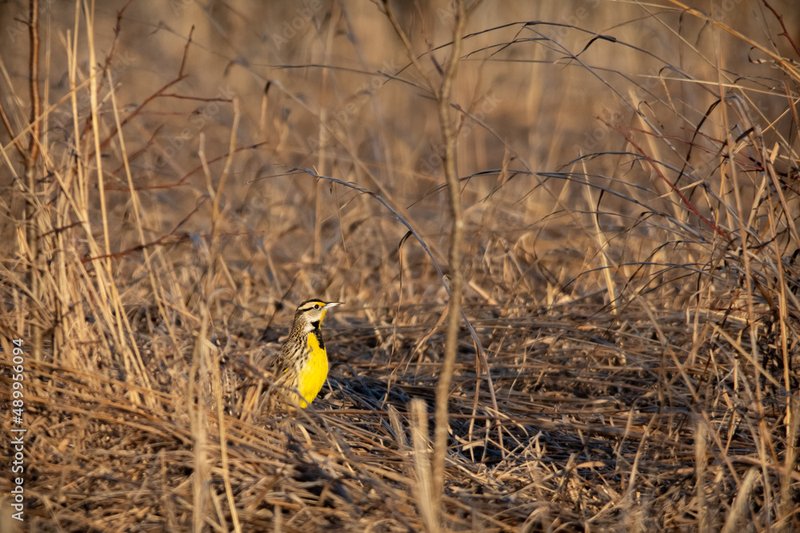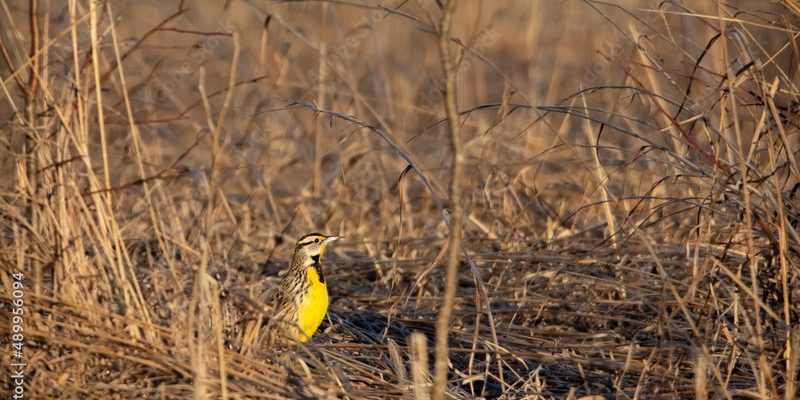
The Eastern Meadowlark is one of those birds that seems to embody the spirit of open fields and sunny skies. With its bright yellow belly and melodious song, it’s a delightful sight and sound for those who venture into its habitat. Imagine walking through a lush green meadow on a warm spring day, and suddenly, you hear a sweet, harmonious tune floating through the air. That’s the Eastern Meadowlark making its presence known, often sitting proudly on a fence post or a tall blade of grass, declaring its territory to the world.
These birds are often found in fields, grasslands, and pastures, where they blend perfectly with their surroundings. Their natural camouflage, combined with their beautiful vocalizations, makes them one of the most charming birds you might encounter in the eastern United States. But there’s so much more to the Eastern Meadowlark than meets the eye. From their nesting habits to their diet, these birds have fascinating behaviors that make them truly special.
Physical Characteristics
The Eastern Meadowlark is not just pretty; it’s also notable for its distinct physical features. Adult Eastern Meadowlarks typically measure about 7.5 to 10 inches in length, with a wingspan of around 14 to 16 inches. Its plumage is a mix of brown and black streaks on the back with a striking yellow breast that boasts a signature black “V” marking. This coloration allows them to blend into their grassy environments while also displaying their vibrant side when needed.
One can easily recognize this bird not only by its appearance but also by its song. The Eastern Meadowlark’s sweet, whistling melody can soar up to a mile away on a calm day. Their songs serve various purposes, including attracting mates and defending their territory. So, when you hear that lovely tune, you know you’re in the presence of a true musical talent!
Habitat and Distribution
Eastern Meadowlarks thrive in open habitats where grasses are plentiful. They prefer environments like grasslands, pastures, and agricultural fields. Their range extends primarily throughout the eastern and central United States and into parts of Canada. During the winter months, many Eastern Meadowlarks migrate south towards warmer areas, although some hardy individuals remain in milder northern regions.
These birds are quite adaptable, often found in human-altered landscapes like golf courses and parklands. They require a combination of tall grass for nesting and shorter grass for foraging. If you’re hoping to spot one, keep your eyes peeled for them perched on fence posts or foraging on the ground, looking for insects and seeds.
Diet and Feeding Habits
When it comes to food, Eastern Meadowlarks are omnivorous, enjoying a diet that includes a variety of seeds, insects, and even some fruits. They’re particularly fond of insects during the breeding season when they need extra protein for their young. This adaptability in diet helps them thrive in diverse environments.
These birds employ a foraging technique where they hop around on the ground, searching through the grass for food. Their strong beaks are perfect for cracking open seeds, and their keen eyesight helps them spot insects camouflaged among the blades of grass. If you’re watching these birds in action, you might notice them pulling food from the ground and even darting about to catch flying insects.
Nesting Habits
During the breeding season, which runs from April to August, Eastern Meadowlarks are busy building nests. They typically construct their nests on the ground in tall grass or in a clump of vegetation. The nest is a simple structure made from dried grasses and sometimes lined with soft materials like feathers to keep the eggs warm and cozy.
Females lay an average of 4 to 6 eggs, which are usually a pale blue or greenish color. After about 12 days of incubation, the chicks hatch and are reliant on their parents for food and protection. It’s a busy time for these parents, as they must feed their hungry brood frequently. The young birds fledge after about 10 days, but they often remain dependent on their parents for a little while longer before venturing out on their own.
Behavior and Social Structure
The Eastern Meadowlark is known for its social behaviors, especially outside the breeding season. You might see them foraging in small groups, particularly during migration. They have a unique way of communicating, using their songs and calls to establish territory and attract mates. Males are especially vocal, and their singing can fill the air with lovely melodies.
Interestingly, while they can be solitary, they do enjoy the company of other meadowlarks, particularly during feeding times. Their social nature comes into play, as they often share feeding grounds and carefully watch each other for signs of danger. It’s a great survival tactic that benefits them as they navigate the challenges of their environment.
Conservation Status
The conservation status of the Eastern Meadowlark is currently of concern. While these birds are still widespread, habitat loss due to agricultural practices, urban development, and changes in land use are threatening their populations. Conservation efforts are underway to protect their natural habitats and promote sustainable land use practices that allow for grassland preservation.
Birdwatchers and conservationists alike are working to raise awareness about the importance of grassland ecosystems. By preserving these habitats, we help ensure that future generations can enjoy the enchanting songs and vibrant colors of the Eastern Meadowlark.
| Characteristic | Details |
| Size | 7.5 to 10 inches in length |
| Wingspan | 14 to 16 inches |
| Diet | Seeds, insects, and fruits |
| Habitat | Grasslands, pastures, and agricultural fields |
| Breeding Season | April to August |
| Eggs per Clutch | 4 to 6 eggs |
| Conservation Status | Concern due to habitat loss |
Fun Facts about Eastern Meadowlarks
Did you know that Eastern Meadowlarks can sing a variety of tunes? They have been known to mimic the songs of other birds, adding a layer of complexity to their vocalizations. This skill not only showcases their intelligence but also helps them adapt to different environments.
Another interesting fact is that these birds have excellent vision, which is crucial for spotting predators and finding food. Their keen eyesight allows them to detect changes in their surroundings quickly, helping them stay safe from threats while foraging.
How to Spot an Eastern Meadowlark
If you want to catch a glimpse of an Eastern Meadowlark, head out to open fields during the warm months. Look for them perched prominently on fence posts or low trees, where their bright yellow bellies stand out against the backdrop of green grass. Listening for their distinctive songs can also lead you to their location.
Early morning or late afternoon are ideal times for birdwatching, as these birds are especially active during these hours. Bring binoculars, and be patient; with a little luck, you’ll witness their graceful movements and charming songs that make them a joy to observe. It’s all part of the experience of enjoying nature!
FAQ
What does the Eastern Meadowlark eat?
The Eastern Meadowlark primarily eats seeds, insects, and fruits. Insects are particularly important during the breeding season because they provide the necessary protein for growing chicks. They forage on the ground, using their strong beaks to dig through the grass and find food.
Where can I find Eastern Meadowlarks?
You can find Eastern Meadowlarks in open grasslands, fields, and pastures throughout the eastern and central United States. They prefer areas with tall grasses for nesting and shorter grasses for foraging. They often perch on fence posts, making it easier to spot them from a distance.
Are Eastern Meadowlarks migratory?
Yes, Eastern Meadowlarks are partially migratory. Many individuals migrate south during the winter months, seeking warmer climates, while some remain in milder northern regions. Their migratory patterns can vary depending on factors like food availability and habitat conditions.
How do Eastern Meadowlarks communicate?
Eastern Meadowlarks communicate through a variety of songs and calls. Males are especially vocal during the breeding season, using their melodic songs to attract females and establish their territory. Their songs can be complex, and they are known to mimic the calls of other birds.
What is the average lifespan of an Eastern Meadowlark?
The average lifespan of an Eastern Meadowlark in the wild is around 4 to 6 years, though some may live longer under the right conditions. Predation, habitat loss, and environmental factors can all impact their life expectancy.
How can I help protect Eastern Meadowlarks?
You can help protect Eastern Meadowlarks by supporting conservation efforts that focus on grassland habitat preservation. Advocating for sustainable land use practices, participating in local birdwatching groups, and spreading awareness about their plight are effective ways to contribute.
What does the Eastern Meadowlark’s nest look like?
The nest of an Eastern Meadowlark is typically a simple structure made from dried grasses, built on the ground in tall grass or vegetation. The inside is often lined with softer materials like feathers to provide warmth for the eggs. They are cleverly concealed to protect against predators.
What is a unique behavior of Eastern Meadowlarks?
One unique behavior of Eastern Meadowlarks is their ability to mimic the songs of other birds. This skill not only adds variety to their vocalizations but also helps them adapt to different environments by blending in with other species.
Are Eastern Meadowlarks social birds?
Yes, Eastern Meadowlarks can be quite social outside of the breeding season. They often forage in small groups and communicate through songs and calls. Their social behavior helps them stay alert to potential dangers while feeding together.
How do Eastern Meadowlarks find food?
Eastern Meadowlarks find food by foraging on the ground. They hop around in search of seeds, insects, and other edibles. Their excellent vision allows them to spot potential food sources and detect any threats quickly. This makes them efficient foragers in their grassy habitats.

